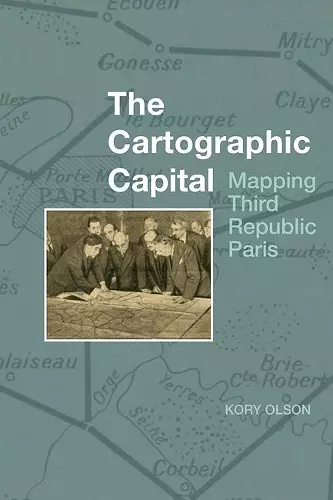The Cartographic Capital
Mapping Third Republic Paris, 1889-1934
Format:Paperback
Publisher:Liverpool University Press
Published:1st Sep '21
Should be back in stock very soon

Through official maps, this book looks at how government presentations of Paris and environs change over the course of the Third Republic (1889-1934). Governmental policies, such as the creation of a mandatory national uniform educational system that will eventually include geography, combined with technological advances in the printing industry, to alter the look, exposure, reception, and distribution of government maps. The government initially seemed to privilege an exclusively positive view of the capital city and limited its presentation of it to land inside the walled fortifications. However, as the Republic progressed and Paris grew, technology altered how Parisians used and understood their urban space. Rail and automobiles made moving about the city and environs easier while increased industrialization moved factories and their workers further out into the Seine Department. During this time, maps transitioned from reflecting the past to documenting the present. With the advent of French urbanism after World War I, official mapped views of greater Paris abandoned privileging past achievements and began to mirror actual residential and industrial development as it pushed further out from the city centre. Finally, the government needed to plan for the future of greater Paris and official maps begin to show how the government viewed the direction of its capital city.
Reviews 'A meticulous study of the mapping of Paris from the Third Republic to the eve of the Second World War, The Cartographic Capital brings force and coherence to the history of cartography, urbanism and to cultural and visual studies in general.'
Tom Conley, Harvard University
‘Olson’s book is…a useful study, starting from historical maps to propose relevant developments in the fields of urban history, history of cartography, history of ideas and town planning practices, and even French political and social history. The book is particularly welcome as the trope of ʻle Grand Parisʼ re-emerged in the national planning perspective of 2008, creating a new interest for the history and representation of the concept.’
Gilles Palsky, Imago Mundi
'Olson’s book makes a unique and worthy contribution to the history of cartography and the history of modern Paris. It is a useful and readable text for anyone interested in Third Republic Paris who wishes to orient themselves geographically and spatially in the city’s shifting physiognomy. Through Olson’s careful analysis, we see how the map archive has much to teach us about the history of core/periphery relationships, boundary-making, and infrastructure development in modern Paris.'
Catherine Dunlop, H-France Review
ISBN: 9781800855854
Dimensions: unknown
Weight: unknown
320 pages